
| Product Name | Lifetime | Colors | |||
|---|---|---|---|---|---|
| In The Swim Super Poxy Shield (Editor`s Choice) | 5 - 8 years | White Pool Blue Dark Blue Black | Check Price | ||
| Olympic Zeron Epoxy Pool Coating | Up to 8 years | White Blue Mist Blue Ice Bikini Blue | Check Price | ||
| ZINSSER Pool Paint | w/ Acr. Resin | 3 - 5 years | White Blue | Check Price | |
| In The Swim Aqua Coat | Acrylic | 3 - 4 years | White Pool Blue Dark Blue | Check Price | |
| AdCoat Swimming Pool Paint | Waterbased | Up to 20 yrs** | White Cool Blue | Check Price |
* Coverage is approximate.
** Such result only for concrete fresh water pond.
So, if you’re ready, let’s dive right in.
Table of Contents
1. In The Swim Super Poxy Shield – Best Epoxy Pool Paint

However, application may not be the easiest, requiring pre-painting preparations such as scrubbing, acid washing, and priming. Nevertheless, with the right tools, instructions, and accessories, the task can be efficiently completed. The versatility of this product is also remarkable, as it can be used on various pool surfaces, fountains, bird baths, hot tubs, and many more.
- Stylish and durable high-gloss finish
- Only takes a single application
- Stain-resistant
- Great for a variety of pool surfaces
- Different color options
- Thick, heavy, and a little tough to apply
2. Olympic Zeron Epoxy Pool Coating – Best Swimming Pool Paint
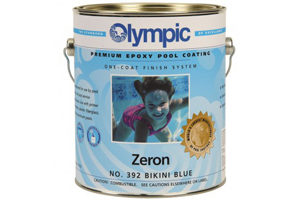
When it comes to durability, the Olympic Zeron Epoxy Pool Coating stands in a league of its own. When properly applied, it yields a flawlessly smooth pool surface that can endure for up to eight years, making it one of the longest-lasting pool paints available in the market.
Moreover, the Zeron Epoxy coating not only excels in durability but also in visual appeal. Its sleek and sophisticated high-gloss finish adds a touch of resort-style elegance to any backyard setting, creating an irresistible allure that beckons swimmers to immerse themselves in its inviting waters.
However, it is imperative to ensure that you possess the appropriate tools and expertise before embarking on the application process. Similar to all epoxy pool paints, the Zeron coating necessitates a meticulously cleaned, dry, and primed surface to achieve the best possible finish and adhesion.
The positive news is that your diligent preparation efforts will yield substantial returns, as you will enjoy nearly a decade of swimming in a splendid pool before needing to undergo the process anew.
- Super durable
- Inhibits algae growth
- Great for sealing
- Perfect for refinishing and new construction
- Makes a great plaster alternative
- Must use primer and proper prep to avoid bubbles
3. ZINSSER Pool Paint – Best Concrete Pool Paint

This quick-drying paint is also incredibly versatile and can be used to seal and waterproof concrete, masonry, gunite, and plastered pools. Plus, it’s ready for use right out of the can with no mixing or anything else required, aside from the basic prep work that is.
It’s also not ideal for fiberglass pools. Nonetheless, if you’re looking for a great all-around pool paint for your in-ground pool and want one that’s quick and easy to apply, this quick-drying Rust-Oleum may be just right for you.
- Easy to use and quick to apply
- Ready right out of the can
- Quick-drying
- Great for in-ground and above ground pools
- Compatible with a variety of pool surfaces
- Great Caribbean-like color
- Not much of a shine
- Not as durable as epoxy
4. In The Swim Aqua Coat – Best Acrylic Pool Paint
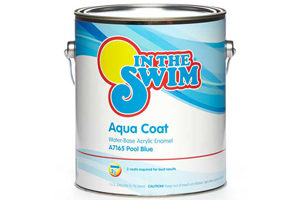
Although Aqua Coat dries remarkably fast, at least two coats are needed for the initial application. However, the overall downtime for most pool owners is only three days. Plus, it’s able to cover up to 275 square feet per gallon, which is quite impressive, especially for a water-based paint.
Despite being water-based, Aqua Coat is a durable acrylic enamel designed to look great and withstand years of abuse. Along with its easy application and budget-friendly price, it’s a great option any way you slice it. If you want a decent finish in a short time and at a fair price, In The Swim Aqua Coat might be for you.
- Water soluble
- Easy to use
- Dries fast
- Great coverage
- Colors are a bit misleading
- Not quite as durable as epoxy
5. AdCoat Swimming Pool Paint – Best Paint for Fiberglass and Gunite Pool
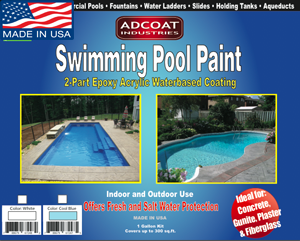
What’s really impressive, however, is the AdCoat’s unique acrylic resin formulation. While other swimming pool coatings chalk and fade in the sun, its cured finish defends against solar rays to minimize any signs of degradation.
With up to 300 square feet of coverage, you’ll also find you won’t need much to get the job done. In fact, it has better coverage than 99 percent of the other pool paints on the market. Combined with its reasonable price, this makes it a great value and an awesome buy as well.
- Great value
- Excellent coverage
- Easy to apply
- Very durable
- Bonds and seals great
- Extremely versatile
- Some may prefer a simpler single-can solution
Pool Paint – Buyer’s Guide
Pool paint can make or break your swimming pool. Choose the right paint and your above ground pool will look like Shangri-La. Choose the wrong paint and your sprawling in-ground pool will look worse than before, if not now, sometime in the near future.
To choose the right paint and make your swimming pool look like a million bucks, you need to know a little about pool paint. Wouldn’t you agree?
Keep reading to learn all you need to know!
Types of Pool Paint

Epoxy Pool Paint
Epoxy swimming pool paint is solvent-based and te most durable of the bunch. They’re resistant to abrasions, chemicals, stains, and more. In fact, they’re so durable most epoxy pool paints are developed to last for up to eight years.
Some epoxies have a silky satin finish, while others have high-gloss finishes for those desiring a super clean and stylish look. In term of materials, epoxy pool paint can be applied to unpainted concrete, gunite, plaster, and fiberglass. They can also be used on pools with existing epoxy coatings for a fresh look and to smooth rough surfaces.
Most epoxy pool paints come in two-gallon kits, which must be mixed prior to application. The drying time of epoxy is also the longest of all pool paints. In fact, most outdoor pools take up to a week to properly dry, while indoor pools can take twice as long.
Epoxy paints also have a tendency to chalk over time due to exposure to the sun and pool chemicals. The best epoxies, however, are much more durable and UV-resistant.
Acrylic Pool Paint
Acrylic paint has an appealing high-gloss finish that looks great on almost any pool. It also has a drying time of five days for outdoor pools. It may be tempting, but acrylic paint should not be used on fiberglass surfaces or hot tubs and spas. It’s more susceptible to chemicals than epoxy and may chalk over time. Therefore, most acrylic pool paints have a life expectancy of about four years.
Water-Based Acrylic Pool Paint
On the other hand, water-based acrylic also has the shortest lifespan. In fact, commercial pools will need to be repainted annually and residential pools every other year.
Back on the bright side, water-based acrylic paint is surprisingly versatile. It can be used on plaster, unpainted concrete, and pools previously coated with epoxy, acrylic, or synthetic rubber. If you have a gunite or fiberglass pool, however, it may not be for you.
Water-based acrylic is also usually available in only one color: eggshell white. While you can find certain brands offering a few different color selections, it certainly won’t have a dramatic effect on the color and clarity of your pool water.
How to Test for the Right Paint
While there are some high-quality pool paints that can do a good job and look great overtop of another type of paint, it’s best to repaint a pool with its current paint type. For instance, if your pool is coated with an epoxy pool paint, repaint it with epoxy. If acrylic was used, then use acrylic. You get the drift.
If you have no idea what type of paint is on your pool, you can find out by performing a paint chip test.

- Chip off a tiny piece of paint.
- Rub the paint chip in a few ounces of epoxy or acrylic paint solvent.
- If the chip begins to dissolve in a solvent within a minute or so, you have a match. For example, if the chip dissolves in epoxy paint solvent, it is epoxy paint.
A lot of people neglect to think about this step, but it could be the key to a great looking pool rather than a DIY project gone wrong.
How Much Paint Should I Buy?
The answer to this question depends on a variety of factors, such as the size of your pool, the paint you’ve chosen, and how many coats you’ll need to apply. Some paints have better coverage than others, so it takes less paint to get the same effect.
While many quality pool paints can cover up to 150 square feet, some can cover up to 300 square feet or more. However, some of these paints may require an extra coat, so you have to keep that in mind as well. Rough, pitted, or unpainted surfaces will require more paint.
The goal should be to get all of it painted at once to ensure a nice and consistent application. If you have excess paint, you can start rolling it on more thickly as the paint begins to dry, especially on the steps and around the drains for added protection.
Pool Paint Calculation Guide

• Length x Width x 1.7
If you’re applying two coats of paint, multiply the answer by two. This will give you the entire square footage that needs to be covered. Then, divide that number by the square feet one can of your paint is able to cover. For example, if you bought a can of premium acrylic with up to 300 square feet of paint coverage, you would do the following:
- Single coat: Length x Width x 1.7 / 300
- Two coats: Length x Width x 1.7 x 2 / 300
One of these simple equations will tell you exactly how many gallons of pool paint you’ll need.
Primer – Is It Really Necessary?
It may not be a must all of the time, but primer is ALWAYS a good idea. If you’ve never painted before, primer should be rolled or sprayed on the pool surface prior to the paint in order to maximize adhesion.
For unpainted pool surfaces, primer is a must for the best bond. However, if you’re using an acrylic or old school rubber-based pool paint, you don’t necessarily need primer as the first coat will serve the same purpose.
Epoxy paints, on the other hand, almost always need primer. But only one coat may be needed, so pick your poison. If you’re painting bare concrete, gunite, or rough surfaces with epoxy, primer is a must in order to smooth the surface and provide the best bond.
Avoiding Bubbles and Blisters
Bubbles and blisters are a common occurrence when painting a pool, but they’re almost always the result of improper preparation and poor adhesion. Your pool must be clean and dry before applying paint. If your pool surface isn’t dry, clean, and the right temp, or if the paint is applied too thick, the paint will bubble and blister.
If the paint does blister, the best course of action is to prep and paint the pool again, or at least the spots. So, it’s best to get it right the first time. If you clean the pool with a TSP degreaser, scrub it thoroughly to remove all of the oils and minerals, make sure it’s dry, and wait until it’s cool and sunny outside, you should have no bubbling or blistering issues with your new swimming pool paint.
Pool Painting Prep
The best paint in the world won’t turn out looking as good as it should if your pool is rough and poorly prepped. If your pool is in need of a little TLC, you’ll need to get the right supplies, roll up your sleeves, and get ready to clean.
Pool Painting Supplies:
- Paint mixer drill attachment
- Painter’s tape
- Paint roller with 3/8-inch nap
- Paint roller frame and extension pole
- Trim brushes
- White sand for steps
To properly prepare your pool surface for paint, you must first drain all of the water out of the pool. Then, remove any oils or grease you see on the surface. To do so and clean the surface, use a tri-sodium phosphate solution (TSP), flower waterer, and a scrub brush to thoroughly scrub the surface. Then, rinse thoroughly and voila!
After the surface is cleaned and degreased, it’s time for everyone’s favorite job: removing the mineral deposits. This is done by acid washing the surface. Don’t worry; it’s not as bad as it sounds. You can use Sulfamic Acid cleaner or diluted muriatic acid, both of which are widely available online and at most pool stores. In addition to removing mineral deposits, acid washing etches the surface for a better bond and paint adhesion.
How to Acid Wash a Pool
Fiberglass swimming pools must be sanded prior to paint. Rather than acid etching, the entire pool must be sanded with coarse sandpaper and then cleaned with TSP.
Before you rush to grab a roller and brush, clean the pool deck and surrounding area to make sure it’s clean of debris that may fly in the pool. Also, check the weather forecast. It’s never a wise idea to paint in windy or rainy weather.
How to Paint a Pool
Best Pool Paint – Bottom Line
Okay, you’re now armed with more than enough information to pick out a quality pool paint and turn your worn out pool into an inviting jewel just waiting to be enjoyed.
Painting your swimming pool is a quick and easy way of boosting your pool’s appearance. Best of all, it’s inexpensive too. In fact, most pools can be painted for under $1 a square foot.
Ready to paint? Great!
Browse the pool paints above one more time, check out the rest of our site to learn more helpful tips and tricks, and get ready to dive into a fresh sparkling pool in no time at all!



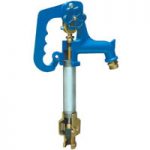
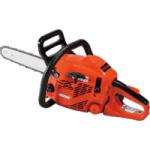
Great video! I truly appreciate business owners who include videos in their blog posts. I found it very interesting to watch and learn about using a chlorinated rubber paint. After my husband probably already thinks I know or should know, that chlorinated rubber paint exists but shhh we won’t tell him.
we need an epoxy paint for swimming pool. size 30mtr x 15 mtr .
For the DIY’s, there are two things that will determine the outcome of your pool painting project. Preparation and paint mixing. Your pool MUST be 100% prepared / cleaned or you are going to have the “it peeled off” problems you read about. Any spots that are missed that leave behind cleaning solvents, soap, acid, or tanning oils WILL PEEL OFF. Next, mixing your paint. Even one part paints will divide while sitting on the self or in storage. Professional paint stores “box” their paints (flip them over periodically) to help keep them mixed. Two part epoxy paints are even harder to mix correctly. Paints have a catalyst and a pigment (color), epoxy includes a hardener that is kept separate until mixed to be used. Both paints MUST BE MIXED THOROUGHLY. Invest in a paint mixer arm that fits a cordless drill (about $5) and use it. When you think it’s mixed enough….mix it again.
Thank you for your tips Rick!
Hi, could you advise if there is a paint for vinyl PVC. I want to paint above the water line over a faded vinyl border. Thank you
Hi Paul!
I`m not such big expert in PVC liners. IMO PVC is not for painting, especially in pools. I could be wrong…
hi we have a reasonably new fibre glass pool it has black cobolt staining. comming through the gell coat. this has happened twice now first time we had the gell coat removed and then re done. do any of these paints stop this and that can be put on the gell coat or is it a rub down and start again and if so what paint would you advise. Thank You
Hello David!
You would need to clean the pool with TSP and muriatic acid, followed by TSP cleaning again. Afterwards you prime the pool for proper adhesion.
Hello.
Apparently, some fiberglass pools experience a problem with blistering that results in dark spots, or cobalt staining. The problem involves a complex chemical reaction that occurs when water penetrates the gel coat. Since we make a waterbased coating, we would not recommend it for this application due to a concern that it will not prevent the cobalt staining issue from recurring.
You can strip and put on a new gelcoat again. Or, there is a possibility that a solvent based paint will stop this moisture penetration, but best to ask the manufacturer of the coating.
Hi I have an above ground para pool, i’m trying to find a paint I can use to put on the outside of the pool without causing any erosion to the vinyl lining, have you any idea what kind to use please ?
Cheers Jo
What is the composition of the outside of the pool? Is it plastic or fiberglass or another material?
I have used all kinds of epoxy coatings over the years and they all chalk- some worse then others. Out here in
San Diego we get alot of sunny days which results in the UV breaking down the coating. The longest lasting coating I have used was a product called Ultra Guard which goes on about 40 mil thick with 2 coats. Used it on
a pool 10 years ago and has held up quite well. It is sold now by a company called Korkote called Armorkote and is supposed to be the same as Ultraguard. Also have to say that epoxy coatings are harder to work with for homeowners not experienced with 2 part materials. The pool prep is mind-numbing and sanding the pool is
usually required. Good info and take care John Southwind pool and spa
Hello David, I live in San Antonio, Tx and we have extreme bouts with heat and hot,sunny days. My pool is a San Jose fiberglass pool that is roughly 25-30yrs old. It has held up and the original homeowners repainted it before I purchased it. So fast forward 12yrs later and the gel coat has come off along with the paint. The fiberglass is now being exposed and I am having a hard time finding an epoxy paint for fiberglass! So many paint reviews that vary in negative reviews.
Our city does not have many pool companies other than the common hardware supply stores.
My plan is to drain, acid wash, dry, and then paint all within a few days due to pool being fiberglass.
Can you please provide guidance and advice on which paint works best for older fiberglass pools!
Thank you, Angela
Hello Angela!
There can be a lot of variables and user influence which may account for some of the negative reviews you’ve read regarding all epoxy pool paints.
You mentioned that the gel coat came off with the paint. This may indicate that the integrity of the fiberglass is in need of repair. If you just paint over it, it may continue to degrade. If the mesh of the fiberglass is showing through, for example, it would need to be patched before painting. Hopefully, this is only occurring in a few areas.
I would suggest thoroughly prepping the surface of your pool then using Gunite primer. Then once the pool has been primed use Super Poxy Shield Epoxy Pool Paint that is available in multiple different colors.
Thank you David for the advice! I will try it in the upcoming week since we will finally get dry, sunny weather!
Angela
I am interested in Painting a Cement Pond with Epoxy Paint, I just poured. So Fresh Cement never been touched is the target. Do I still need to etch the surface ? Di I still need to Prime the surface ?
Please advise?
Hi Paul,
The etching is required yes, all the pool paint can be applied directly to the prepped surface without the need of a primer.